- Home
- Deborah Harkness
The World of All Souls Page 40
The World of All Souls Read online
Page 40
Wooden Box, Rowan (with Tree Carving) (late sixteenth century)
Unattributed
Les Revenants, France
Small box carved of rowan, with a tree incised on the lid, roots and branches intertwined. Held together by nearly invisible joints.
Background: In sixteenth-century London, Diana needed a spell box—a place to store her weaver’s cords and to place her written spells until they were ready for another witch to use. A London wizard made the box for her from the rowan branch that Corra the firedrake gave Diana on the night she cast her forspell. Marjorie told her the rowan symbolized life and death and that it had chosen Diana because she herself could be in both worlds. When Diana went back to the present day, one of Matthew’s servants hid the box in storage, and it was preserved through the centuries. Diana keeps it at her home, Les Revenants, in France.
Chairs
ELIZABETHAN CARVED ARMCHAIR
This is the type of chair that Diana became accustomed to in the parlor of the sixteenth-century Old Lodge in Woodstock. The Elizabethan design was influenced by Gothic and Renaissance styles from Holland and Germany, with intricate ornamentation and carving, often of fruit and flowers. Elizabethan chairs were usually made of oak.
WINDSOR ROCKING CHAIR
The Windsor chair originated in England and was brought to America by the early English settlers, where the form was refined and perfected. The chair is characterized by a solid wooden seat into which holes are drilled to accommodate the turned pieces that form the back and sides. Windsor chairs were plentiful at the Bishop house in Madison; Sarah sat in one in the keeping room, waiting impatiently as the house spat various objects out of the chimney and walls, summoning Diana so that it could give her a missing page of the Book of Life.
QUEEN ANNE CHAIRS
In the second quarter of the eighteenth century, furniture design evolved to use more curving lines and classical proportions, a style known as late Baroque, early Georgian, or Queen Anne. The corner chair in which Gallowglass sat in the Clairmont House reception room was strong and comfortable—especially for someone like him. It allowed for the necessary manspread. On that same occasion, Ysabeau sat in a high-backed Queen Anne chair. It was upholstered in damask, and its frame was covered in silver leaf.
BIRTHING CHAIR
When Diana was in labor with the twins, she first tried it the modern way, lying down. Marthe, a midwife, immediately saw the trouble: “She needs a stool.”
In medieval and early modern Europe, some women delivered in bed, some kneeling, and some standing while attendants supported them by the arms. Others sat in a birthing stool or chair, also known as a groaning stool, a device that had been used on and off since the days of the ancient Egyptians. The stool or chair had three or four legs, a cutout seat, and often a slanted back. The seat was usually only eight to ten inches off the floor so that the woman had that to brace her feet against. Giving birth in this way allowed gravity to help with the process and reduced the pain of childbirth. Modern birthing chairs are still used in some hospitals today.
MATTHEW’S STRANGE CHAIR
Diana discovered this chair in Matthew’s study when she was prowling around Clairmont House, missing him. “It was surprisingly comfortable, and I imagined Matthew sitting here, reading for hours in the ample light from the windows.”
Matthew’s chair was based on a Georgian-style reading chair at the Victoria and Albert Museum in London, made around 1725–35 of mahogany and leather. It is intended to be sat on backward, facing the book stand at the back, and has swing-out drawers for holding writing tools.
SAVONAROLA CHAIR
A Savonarola chair is an X-shaped folding chair that has narrow, sometimes curved, wooden slats for legs. The X-shaped chair was popularized in medieval Italy, but the form was first known to exist in ancient Egypt, Greece, and Rome. The Savonarola chair received its name in the nineteenth century after the fifteenth-century monk Girolamo Savonarola, because monks often had folding chairs in their cells. Baldwin sat in a Savonarola chair in the de Clermont family library as he awaited Diana and Matthew’s answer to his summons after their return from sixteenth-century London.
CONGREGATION CHAIR: DE CLERMONTS
In the huge chamber of the Congregation headquarters, located on Isola della Stella in the Venetian lagoon, members sit around an oval table on high-backed chairs. These are Renaissance in style, and each has a symbol to match the individual member’s lock and key, including the de Clermonts’. As soon as she entered the room for her first Congregation meeting as a de Clermont, Diana could see instantly which chair was hers.
MORRIS CHAIR
Matthew’s rooms in All Souls College at Oxford held a variety of William Morris furniture, along with an assortment of other antiques. After her first visit, Diana retained a vivid image of him sitting in his Morris chair reading, his forehead creased with concentration.
William Morris was a gifted nineteenth-century English designer who believed that utility and beauty went hand in hand: He famously said, “Have nothing in your houses that you do not know to be useful or believe to be beautiful.” In 1865 his firm Morris, Marshall, Faulkner & Co. in London designed the Morris chair, whose signature features were an adjustable reclining back and comfortable cushions. Within a few years, variations of it were being produced in factories and shops all over the world. The American versions tended to be more angular, with leather cushions, but one suspects that Matthew’s chair would have looked like the one in the illustration, which was actually manufactured by a later incarnation of the Morris company. The beauty-loving Matthew must have felt an instinctive affinity for Morris designs.
Pair of Cradles (twenty-first century)
Les Revenants, France
Two identically carved and painted wooden cradles with curved bases, hanging inside wooden stands on level feet. The cradles are made of rowan wood, with acorn-shaped finials; a firedrake’s sinuous tail provides the arc for the cradles’ rockers. Stand made of American white oak.
Background: After Matthew’s encounter with Ransome in New Orleans in The Book of Life and his reminder of the ravages of blood rage, he felt sickened and unfit to see Diana. Luckily, Fernando had just arrived, and he set out to help Matthew purge himself of lingering remorse and self-hatred so that he could return to Diana as soon as possible. Fernando’s prescription was hard physical labor, building cradles for the coming twins. Matthew and Jack Blackfriars labored for a week and turned out two works of art.
The model for Matthew’s and Jack’s cradles was Perspectival Drawing of a Cradle by the fifteenth-century German designer, sculptor, and printmaker Peter Flötner (c. 1490–1546). It seemed like just the kind of craft project for a carpenter’s son and his first-time apprentice, Jack, to take on.
Carved Tudor Bed (c. 1540)
Clairmont House, London, England
Elaborately carved oak English bed with tester.
Background: The poor in sixteenth-century England slept on straw pallets or mats covered with a sheet. The rich could afford the luxury of a bed, away from the insects and vermin on the rush-covered floors. The standard was a heavy wooden bed with elaborately carved posts and headboard, a tester (wooden canopy supported by the four posts), and often bed curtains to keep out drafts. Mattresses were filled with down and feathers.
When Diana and Matthew first arrived in sixteenth-century England, they slept in just such a bed at their house in Blackfriars, London. Back in the twenty-first century at Clairmont House in London, Diana was delighted to find that her bedroom contained the very same bed, preserved over more than four centuries.
Clock Radio (1975)
General Electric
Bishop House, Madison, New York, USA
Standard 1970s-era clock radio, unremarkable except for the fact that it plays only Fleetwood Mac—and will not stop when unplugged.
Background: When Diana began practicing her magic with Sarah in the Madison house’s stillroom, Sarah was unaccountably distressed to find Rebecca Bishop’s 1970s-era clock radio in one of the cupboards. Her horror grew to a fever pitch when the unplugged radio began to play “Rhiannon” from Fleetwood Mac’s eponymously named 1975 album. Diana’s mother, Rebecca Bishop, had loved Fleetwood Mac and played the album incessantly during her pregnancy with Diana. After two days the desperate Sarah smashed the radio to bits, but the house persevered in playing Fleetwood Mac out of record players, eight-track-tape machines, and finally the furnace. The house continued to serenade them until Diana and Matthew left for New Haven, at which point the car’s radio sent them off with 1977’s “Don’t Stop (Thinking About Tomorrow).” The same model of radio that Sarah destroyed has since reappeared mysteriously in the Bishop house.
Rune Disks (second century)
Private Collection, Exact Whereabouts Unknown
Twenty-four wooden disks, one inch across and a quarter inch thick, with runic symbols burned on. In Elder Futhark, the oldest runic alphabet. Made of ash. Date unknown; possibly second-century Norse.
Background: At the simplest level, runes are the letters that were used in several Germanic alphabets before the Latin alphabet was adopted. But runic symbols probably existed long before the earliest written languages, for purposes of magic and divination. A poem in the collection of Norse poems called the Poetic Edda recommends carving victory runes on swords. And in graves in Norway and Sweden from the fifth century through the seventh, rune-inscribed stones have been found facing the corpse.
A a creature of Norse descent, Gallowglass was familiar with the magical use of runes. After Matthew’s sister Verin called to summon Gallowglass to Sept-Tours for Matthew and Diana’s return from the past, Gallowglass consulted his own set of runes for guidance. For his present circumstances, he drew the rune nyd, which represents absence and desire—clearly referring to his love for Diana. For the future he drew odal, representing home, family, and inheritance. For the rune that would show him how to fulfill his desire to belong, he drew rad. “It was a confusing rune, one that stood for both an arrival and a departure, a journey’s beginning and its ending, a first meeting as well as a long-awaited reunion. Gallowglass’s hand closed around the bit of wood. This time its meaning was clear.”
Venetian Glass Flask (sixteenth century)
The Old Lodge, Woodstock, England
A rare survival of a large glass flask, with a rounded base and funnel neck, from the alchemical laboratory of the Countess of Pembroke, Mary Sidney. Produced by highly skilled Venetian glassmakers.
Background: Venetian glass has been a standard for quality for many centuries. Glassmaking was originally an Eastern skill, and Venice was geographically well placed to learn those superior methods. When Constantinople was captured by the West in 1204 during the Fourth Crusade, Byzantine glassmakers fled to Venice, bringing techniques that would transform the craft. In the late thirteenth century, the factories were moved to the island of Murano, where they are still found today.
By the end of the sixteenth century, there was such a demand for glass that glassmakers had set up shop in other European locations—for example, the English county of Sussex—but nothing matched the quality of Venetian glass. As a wealthy woman in sixteenth-century London, Mary Sidney would have preferred to use Venetian glass for her alchemical experiments. Though Sussex glass was less expensive, it was marred with imperfections and faint shadows, which would have hindered Mary’s view of what was growing inside: in this case the arbor Dianae. This flask found its way into the hands of Matthew Roydon and was miraculously preserved among his collection at the Old Lodge.
Bodleian Library Tote Bag (twenty-first century)
Clairmont House, London
Cotton tote bag featuring the oath that every Bodleian reader must speak aloud before gaining admittance to the library. Size: 410 by 380 by 100 millimeters. Made in England; available from the Bodleian Library shop. Bag: a few quid. Contents: priceless.
Background: When Diana attended her first Congregation meeting, she carried with her the Book of Life in a simple Bodleian Library tote bag, inscribed with the reader’s oath to “hereby undertake not to remove from the Library, or to mark, deface, or injure in any way, any volume, document, or other object belonging to it or in its custody.” Ironic considering that Diana had broken into Duke Humfrey’s and stolen Ashmole 782. The precious Book of Life no longer showed any text, of course—that was written on and within Diana’s body.
Chess Set (twelfth century)
Cadzow Lodge, Scotland
Chess set of 78 pieces, carved out of walrus ivory and ebony. Size ranges from 3.5 centimeters to 10.2 centimeters, depending on the piece.
Background: Shortly after he first met Diana at Oxford, Matthew visited his best friend, Hamish Osborne, at his hunting lodge in Lanarkshire. He was craving Diana and needed to talk. While circling the subject of Diana, the two played billiards, then chess, on a large, ancient chessboard with carved ivory and ebony pieces that Matthew had given to Hamish.
Hamish’s chess set is similar to the famed Lewis chessmen, a set from the twelfth century that was discovered in Scotland in the nineteenth century. Most of the pieces are now at the British Museum in London, with eleven others at the National Museum of Scotland in Edinburgh. The figures look comically glum to the modern eye, but scholars believe their expressions were intended to convey strength and wisdom. When Gallowglass was downsizing, he gave the set to Matthew for safekeeping. Later, when Matthew was looking for a special gift for Hamish’s new house, Gallowglass suggested he give him “that old set of mine that’s gathering dust in the Old Lodge.”
Duchess of Marlborough Cello (1739)
Domenico Montagnana
Private Collection
Varnish: Golden-orange
Back: Two-piece
Length of back: 74.1 centimeters
Upper bouts: 36.1 centimeters
Middle bouts: 26.1 centimeters
Lower bouts: 44.55 centimeters
Background: Domenico Montagnana (1686–1750) was a master maker of violins, violas, and double basses, but he was most famous for his cellos. Montagnana’s style of design was bold and unrestrained, and the carving around the edges of his cellos was downright voluptuous. For this reason Matthew’s cello was dubbed the Duchess of Marlborough, after Sarah Churchill, one of the most famous beauties of the era. There are no records of this cello, but Montagnana did produce a cello named the Duchess of Cleveland in 1740.
Matthew’s cello disappeared from Sept-Tours while he was in New Orleans during the early nineteenth century. Philippe’s explanation was vague, and it was not until Jack Blackfriars showed up in New Haven that Matthew knew what had become of it: Philippe had given it to Jack long before to help him exorcise the twin demons of abuse and blood rage. As Jack covered the walls of Gallowglass’s condo with painful scenes of the violence he had both suffered and inflicted, Matthew played him the Lacrimosa from Johann Christian Bach’s Requiem on this cello.
Montblanc Meisterstück Solitaire Doué Stainless Steel Classique Mechanical Pencil (twenty-first century)
Sept-Tours; Les Revenants; Clairmont House, London; Helderberg Huis, Amsterdam; the Old Lodge, Woodstock
A Meisterstück Solitaire Doué mechanical pencil, made of black resin and stainless steel, in the Montblanc classic design.
Background: Matthew de Clermont is a creature of habit, and when he finds something he likes, he sticks with it. For twenty-first-century writing, he is fond of the Montblanc line of pens and pencils—not because they are stylish, or expensive, but because he likes their reliability and the smooth way they write. Matthew was born in a very different age, and so disposable pens and pencils make no sense to him. Why not buy one you really like and take good care of it? In his study at Sept-Tours, Diana found
that the top right-hand drawer of his desk held Montblanc pens neatly separated from the Montblanc mechanical pencils, and paper clips arranged by size. In the Bodleian he uses a mechanical pencil, since pens are prohibited to protect the priceless manuscripts from harm.
Iron Key (fifteenth century)
Private Collection
Approximately 12 centimeters long, heavy and ornate. Decorated with a bow in the shape of an ourobouros and star-shaped wards. Made in 1454. From the de Clermont private collection.
Background: When Matthew was captured by Benjamin in The Book of Life, Diana was tasked with convincing the Congregation to help rescue him. Initially she was puzzled as to how she could serve as a Congregation member, because she was neither a vampire nor a de Clermont. But Baldwin observed that the de Clermont representative did not have to be a vampire and that as Philippe’s blood-sworn daughter, she was a de Clermont. And so he handed over to her their family’s ornate key to the council chamber’s door.
At the Congregation’s headquarters on Isola della Stella, each of the eight other Congregation members had his or her own key, too, slotted into the respective locks of the council chamber’s door. Diana inserted hers into the ninth, and so her first Congregation meeting began.
Sword (late sixteenth century)
Armaments Room, Armory Tower, Sept-Tours, France

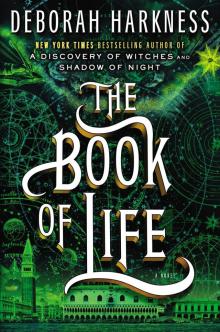 The Book of Life
The Book of Life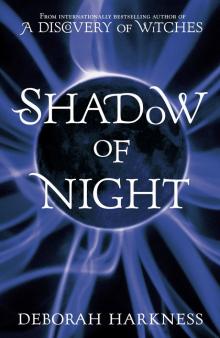 Shadow of Night
Shadow of Night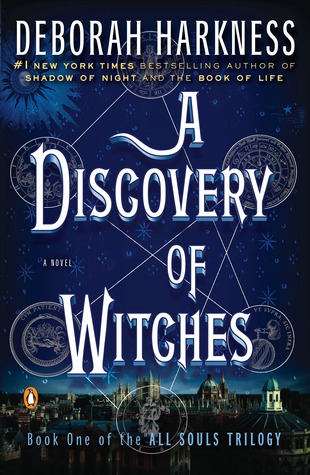 A Discovery of Witches
A Discovery of Witches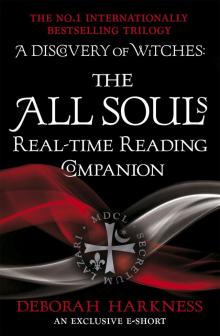 The All Souls Real-Time Reading Companion
The All Souls Real-Time Reading Companion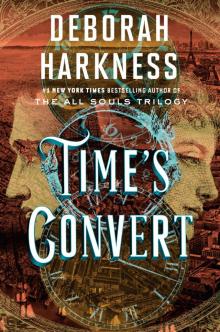 Time's Convert
Time's Convert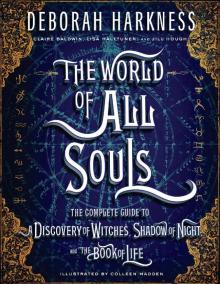 The World of All Souls
The World of All Souls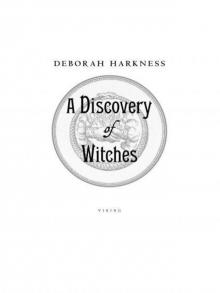 A Discovery of Witches: A Novel (All Souls Trilogy)
A Discovery of Witches: A Novel (All Souls Trilogy) Shadow of Night: A Novel
Shadow of Night: A Novel